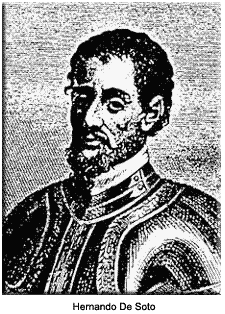 Hernando De Soto was born in Barcarrota, Spain in either 1496 or 1500. Little is known about his early life, but he chose a career in the military and served in several Central American campaigns. In 1530, he joined Francisco Pizarro in the conquest of the Incas in Peru. De Soto was disgusted by the needless slaughter, but willingly pocketed a fortune in gold.
Holy Roman Emperor Charles V (who also was king of Spain) appointed De Soto governor of Cuba and directed him to take possession of Florida, which at that time was a term applied by the Spanish to North America. In 1539, De Soto led a force of 600 men to a site near present-day Tampa to begin a search for gold and other valuables. They marched into the interior and wintered near Tallahassee. In 1540, the force moved northward into the areas that would become Georgia and the Carolinas, and then circled into Tennessee and down to Alabama. Resistance from native tribes was common, stemming from the Spaniards’ practices of taking Indian food supplies, destroying their homes and forcing captives into slavery. De Soto was wounded in one such encounter. The soldiers' spirits flagged and their leader, wanting to press on, chose not to inform them that Spanish ships were available for departure in the nearby Gulf of Mexico.
In the spring of 1541, De Soto and his men crossed the Mississippi River, perhaps near present-day Memphis, and are credited with being the first Europeans to view that great body of water. Pushing westward, De Soto and his men followed the Arkansas River into the area that would become Oklahoma. They were disappointed with their inability to find treasure and turned back toward the Mississippi. On this leg of the trip, De Soto became ill from a fever and died. His death was a threat to the existence of the small army, since the Spaniards had told the hostile natives that De Soto was immortal; a major attack would be expected if the explorer’s body were discovered. De Soto’s remains were placed in a hollowed out tree trunk, fitted with weights and cast into the river.
Despite their leader's passing, the soldiers again pressed westward, following the Red River into northern Texas. No evidence of gold was encountered and the soldiers returned to the Mississippi, constructed rafts and floated out into the Gulf. By the time the explorers found Spanish settlements along the eastern coast of Mexico, only about one-half of the original group remained.
De Soto’s venture left behind the bodies of several hundred fallen comrades and a legacy of death, distrust and disease among the natives.
Hernando De Soto was born in Barcarrota, Spain in either 1496 or 1500. Little is known about his early life, but he chose a career in the military and served in several Central American campaigns. In 1530, he joined Francisco Pizarro in the conquest of the Incas in Peru. De Soto was disgusted by the needless slaughter, but willingly pocketed a fortune in gold.
Holy Roman Emperor Charles V (who also was king of Spain) appointed De Soto governor of Cuba and directed him to take possession of Florida, which at that time was a term applied by the Spanish to North America. In 1539, De Soto led a force of 600 men to a site near present-day Tampa to begin a search for gold and other valuables. They marched into the interior and wintered near Tallahassee. In 1540, the force moved northward into the areas that would become Georgia and the Carolinas, and then circled into Tennessee and down to Alabama. Resistance from native tribes was common, stemming from the Spaniards’ practices of taking Indian food supplies, destroying their homes and forcing captives into slavery. De Soto was wounded in one such encounter. The soldiers' spirits flagged and their leader, wanting to press on, chose not to inform them that Spanish ships were available for departure in the nearby Gulf of Mexico.
In the spring of 1541, De Soto and his men crossed the Mississippi River, perhaps near present-day Memphis, and are credited with being the first Europeans to view that great body of water. Pushing westward, De Soto and his men followed the Arkansas River into the area that would become Oklahoma. They were disappointed with their inability to find treasure and turned back toward the Mississippi. On this leg of the trip, De Soto became ill from a fever and died. His death was a threat to the existence of the small army, since the Spaniards had told the hostile natives that De Soto was immortal; a major attack would be expected if the explorer’s body were discovered. De Soto’s remains were placed in a hollowed out tree trunk, fitted with weights and cast into the river.
Despite their leader's passing, the soldiers again pressed westward, following the Red River into northern Texas. No evidence of gold was encountered and the soldiers returned to the Mississippi, constructed rafts and floated out into the Gulf. By the time the explorers found Spanish settlements along the eastern coast of Mexico, only about one-half of the original group remained.
De Soto’s venture left behind the bodies of several hundred fallen comrades and a legacy of death, distrust and disease among the natives.